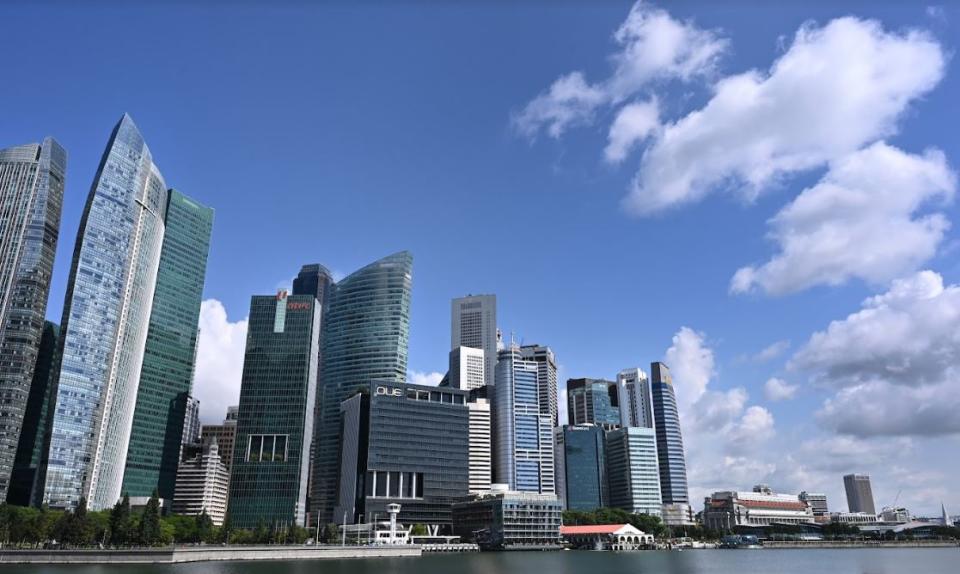CLSA lifts all three TPs of Singapore banks on higher-than-expected NIMs

The banking sector is also the only sector in the market to benefit from the rising rates, note the analysts at CLSA.
CLSA analysts Neel Sinha and Lin Daxin are remaining “overweight” on the Singapore banking sector as they foresee all three banks to report higher-than-expected net interest margins (NIMs) and earnings or net profit after tax (NPAT).
“Fed fund rates are on a trajectory higher than we initially expected, driving our adjustments to NIM assumptions and NPAT upwards,” the analysts write in their Oct 12 report.
The sector is also the only sector in the market to benefit from the rising rates, they point out.
Following the recent announcement made by the US Federal Reserve (US Fed), CLSA’s chief economist has raised his outlook to 4.75% by February 2023. This is before any easing with hikes of 75 basis points (bps), 50 bps and 25 bps to come.
“This is [around] 50 bps higher than prior estimates in our banks’ forecasts, although actual NIM impact would be dependent on other factors like funding cost,” the analysts note.
On this, Sinha and Lin have made “various adjustments” to their NPAT forecasts “primarily in areas of upward NIM adjustments from interest rates, lower non-interest income fees as the rates cycle will keep wealth management fees depressed until mid-2023 in our view.”
The analysts have also adjusted their cost-to-income ratios downwards “as an outcome (in part factoring in DBS’s and UOB’s integration costs of acquiring Citigroup’s retail assets in the region)”.
“Our DBS NPAT forecasts for FY2022/FY2023/FY2024 have been revised by 1.5%/3.8%/6.3%, OCBC by 6.1%/8.6%/6.4%, and UOB by -3.5%/0.3%/4.0%,” they write. “The lower quantum for UOB is mainly to do with the Citigroup retail acquisition related costs of $700 million - $800 million in the 4QFY2022/FY2023.”
Consequently, the analysts’ target prices 5.9% to $43.40 for DBS; by 9.7% to $15.80 for OCBC; and by 4.2% to $37.30 for UOB. The analysts have also kept their “buy” calls for all three banks.
Risks from the aggressive Fed rate hike cycle
While the higher-than-expected Fed rate hikes have been good for the banks’ NIMs, the pace of the hikes implies two headwinds to watch, the analysts say.
“[These are] funding costs with current account and savings accounts (CASA) to fixed deposit (FD) switching and loan growth slowdown,” they write.
In the previous quarter, the analysts noted that there were some 2%-2.5% declines in banks’ CASA ratios when rates began spiking, while growth in deposits broadly continued to outpace loan growth.
“We expect this trend to continue for another two to three quarters until rates peak out. The impact of this will be a slightly higher funding cost than earlier envisaged, one that we have factored into our forecast revisions,” the analysts write.
In addition, loan growth is likely to see a y-o-y slowdown into 2023 with higher rates and slower economic growth.
“We have revised [our] FY2023 expectations downwards to low single-digit from mid single-digit earlier; UOB is the anomaly on this front with [its] small and medium-sized enterprise (SME) segment loans yet to pick up,” the analysts add.
In addition, the analysts see credit costs increasing by 5 – 10 bps over the coming quarters towards the 20 – 25 bps levels.
This, however, is not material and more of what used to be the norm prior to the excess provisioning through the pandemic, the analysts say.
Expectations for the 3QFY2022 results
As the banks are slated to report their results for the 3QFY2022 ended September in late October or early November, the analysts are expecting to see the banks reporting higher NPAT on a q-o-q and y-o-y basis.
“While our expectations for non-interest income have been revised downwards and we see a y-o-y decline due to wealth management facing headwinds, other fee income bases from cards, transaction services etc., continue to hold up. We expect the net interest income (NII) boost from higher NIM expectations to more than offset the pressure in non-interest income,” they write.
They are expecting DBS to record an NPAT growth of 2% q-o-q and 7% y-o-y for the 3QFY2022. Meanwhile, OCBC is expected to see its NPAT grow 5% q-o-q and 23% y-o-y in the same quarter. UOB is also expected to register a 3QFY2022 NPAT growth of 32% q-o-q and 19% y-o-y.
“Some of the high growth numbers for OCBC and UOB are more to do with base effect; i.e. low specific provisions in prior quarters,” the analysts write.
Share price performance
At their current share price levels, the analysts believe that they do not reflect the NPAT and return on equity (ROE) expansion that comes with the rising rates. This, note the analysts, may have to do with the market’s concerns over a recession.
“We highlight that Singapore banks have modest exposure outside Asia where a hard landing is not expected – all three at sub-20% of asset portfolios,” they write.
Among the three banks, the analysts prefer UOB, followed by DBS and OCBC from DBS, UOB and OCBC previously in order of preference.
“The change in relative preference between UOB and DBS is driven mainly by price action of the stocks,” the analysts write.
Shares in DBS, OCBC and UOB closed at $33.46, $11.70 and $26.39 on Oct 12.
See Also:
Click here to stay updated with the Latest Business & Investment News in Singapore
Lower q-o-q earnings anticipated for plantation stocks in 3QFY2022 reporting season: RHB
Octomate in 'sweet spot' to 'extract potential synergies' for HRnetGroup: Maybank Securities
Get in-depth insights from our expert contributors, and dive into financial and economic trends

 Yahoo Finance
Yahoo Finance 